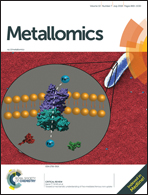Copper-related toxicity in replicating and dormant Mycobacterium tuberculosis caused by 1-hydroxy-5-R-pyridine-2(1H)-thiones†
Abstract
With the emerging primary resistance of Mycobacterium tuberculosis to current drugs and wide distribution of latent tuberculosis infection, the need for new compounds with a novel mode of action is growing. Copper-mediated innate immunity and its antibacterial toxicity pose novel strategies for tuberculosis drug discovery and development. Transcriptome response to 1-hydroxy-5-R-pyridine-2(1H)-thiones, which were found to be highly active in vitro against actively growing and dormant nonculturable M. tuberculosis, revealed signs of copper toxicity. 1-Hydroxy-5-R-pyridine-2(1H)-thiones were found to form stable charged lipophilic complexes with Cu2+ ions that could transport into mycobacterial cells. Copper accumulated inside treated bacilli as subsequent metabolic destruction of the complex led to chemical transformation of 1-hydroxy-5-R-pyridine-2(1H)-thiones and release of free Cu2+ into the cytoplasm. 1-Hydroxy-5-R-pyridine-2(1H)-thiones are a potent class of Cu-dependent inhibitors of M. tuberculosis, and may control infection by impairment of copper homeostasis.



 Please wait while we load your content...
Please wait while we load your content...